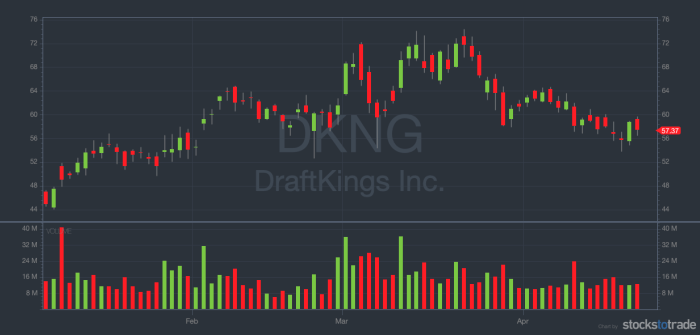Diving into the world of high-volatility stock trading, this introduction sets the stage for an exciting journey through the ups and downs of the market. From the adrenaline rush of quick gains to the gut-wrenching drops, get ready to navigate the unpredictable waters of trading with style and finesse.
In the following paragraphs, we’ll explore the fundamentals, strategies, risk management, and emotional discipline required to thrive in this fast-paced and high-stakes environment.
Introduction to High-Volatility Stock Trading
In the world of stock trading, high-volatility refers to the rapid and significant price fluctuations that occur within a short period of time. This type of trading involves buying and selling stocks that experience extreme price movements, offering the potential for high returns but also carrying a high level of risk.
Factors Contributing to Stock Price Volatility
- Market News and Events: Major announcements, economic data releases, or geopolitical events can significantly impact stock prices.
- Company Earnings Reports: Quarterly earnings reports can lead to sharp price movements based on whether a company meets, exceeds, or falls short of expectations.
- Market Sentiment: Investor perceptions, emotions, and overall market sentiment can influence stock prices, leading to increased volatility.
Risks Associated with High-Volatility Stock Trading
- Increased Losses: The rapid price swings in high-volatility stocks can lead to substantial losses if the market moves against your position.
- Lack of Liquidity: Stocks with high volatility may have lower trading volumes, making it harder to buy or sell shares at desired prices.
- Emotional Stress: Constant price fluctuations in high-volatility stocks can create emotional stress and pressure for traders, impacting decision-making.
Strategies for High-Volatility Stock Trading

Day trading versus swing trading in high-volatility stocks involves different approaches based on the timeframe of holding the stocks. Day trading focuses on short-term price movements within the same trading day, while swing trading involves holding stocks for a few days to weeks to capture potential larger price swings.
Technical Analysis Tools
When trading high-volatility stocks, technical analysis tools play a crucial role in identifying potential entry and exit points. Some commonly used tools include:
- Bollinger Bands: These bands help traders identify overbought or oversold conditions in the stock price.
- Relative Strength Index (RSI): RSI measures the speed and change of price movements, indicating potential reversal points.
- Moving Averages: Traders use moving averages to smooth out price data and identify trends over time.
Importance of Stop-Loss Orders
In volatile markets, stop-loss orders are essential to manage risk and protect capital. These orders automatically trigger a sale when a stock reaches a specified price, limiting potential losses. It is crucial for traders to set stop-loss orders at strategic levels to prevent significant drawdowns in turbulent market conditions.
Risk Management in High-Volatility Stock Trading
When trading high-volatility stocks, it is crucial to have a solid risk management strategy in place to protect your investments and minimize potential losses.
The Role of Diversification
Diversification plays a key role in managing risk when trading volatile stocks. By spreading your investments across different assets or sectors, you can reduce the impact of any single stock’s price movement on your overall portfolio. For example, instead of investing all your capital in one high-volatility tech stock, you could allocate some funds to more stable sectors like utilities or consumer goods.
Risk Management Techniques
– Setting Stop-Loss Orders: Implementing stop-loss orders can help you limit your losses by automatically selling a stock if it reaches a predetermined price level.
– Position Sizing: Properly sizing your positions based on your risk tolerance can help you avoid overexposure to any single stock.
– Using Options: Options contracts can be used to hedge against potential losses or generate income in high-volatility trading scenarios.
– Regular Monitoring: Keeping a close eye on your portfolio and the market can help you react quickly to unexpected events or changes in stock prices.
Impact of Leverage
Leverage can amplify both gains and losses in high-volatility stock trading. While it can increase your potential profits, it also exposes you to higher levels of risk. Using leverage without a solid risk management plan can lead to significant losses if the market moves against your positions. It’s essential to carefully consider the risks involved and use leverage responsibly to avoid excessive risk exposure.
Emotional Discipline in High-Volatility Stock Trading
Maintaining emotional discipline is crucial when trading highly volatile stocks. Emotions like fear and greed can cloud judgment and lead to impulsive decisions that may result in significant losses. It is essential for traders to develop strategies to control their emotions and stay focused on their trading plan.
Tips for Controlling Emotions in High-Volatility Stock Trading
- Acknowledge your emotions: Recognize when emotions like fear or excitement are influencing your decisions.
- Take breaks: If you feel overwhelmed by emotions, take a step back and reevaluate your trading strategy.
- Set realistic goals: Establish realistic expectations for your trades to avoid becoming overly emotional.
- Practice mindfulness: Stay present and focused on the current market conditions without being swayed by past outcomes or future possibilities.
- Utilize stop-loss orders: Implement stop-loss orders to limit potential losses and reduce emotional decision-making.
Psychological Challenges Faced by Traders in Volatile Markets
- Fear of missing out (FOMO): Traders may feel pressured to enter or exit positions quickly due to fear of missing out on potential profits.
- Loss aversion: Traders may be more sensitive to losses than gains, leading to irrational decision-making.
- Overconfidence: Success in volatile markets can lead to overconfidence, causing traders to take excessive risks.
Importance of Having a Trading Plan and Sticking to It
“Plan your trade and trade your plan.”
Having a well-defined trading plan helps traders stay disciplined and avoid emotional reactions to market fluctuations. By outlining entry and exit points, risk management strategies, and profit targets in advance, traders can reduce the impact of emotions on their decision-making process.
